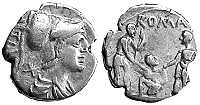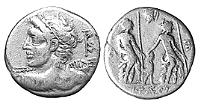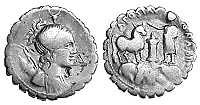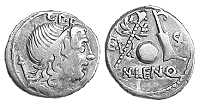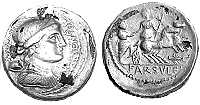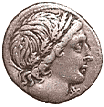 |
Silver Coinage of the Roman Republic
By Kevin Barry |
| Triumviri Monetales |
 As you probably know, today in the US we have a Mint Director who is appointed and is responsible for the coining and printing of our money. The same holds true for most other nations. In ancient Rome they had a slightly different model.
As you probably know, today in the US we have a Mint Director who is appointed and is responsible for the coining and printing of our money. The same holds true for most other nations. In ancient Rome they had a slightly different model. The Roman Moneyers (or you may prefer the title of Mint Magistrates) were also responsible for the minting of gold, silver and bronze coinage and they reported to the Senate. They were known as the Triumviri Monetales or Triumviri Auro, Argento, Aeri, Flando, Feriundo which is abbreviated as III VIR. A.A.A. F.F. which may be translated as 'Commision (or college) of three men under whom gold, silver and bronze coins were struck'. (Note that the order of the metals varies according to different references.) The title 'III VIR. A.A.A. F.F.' occurs rarely on Republic coins and when it is present it is usually seen in an abbreviated form such as 'III VIR'. It is interesting to note that the full title occurs frequently on the reverses of Augustan Aes.
This college consisted of three men, elected to single year terms. They had complete control over the design and production of coins during their term of office. It is apparent from historical records that serving a term as magistrate was often a step to higher office, such as the Senate. While the majority of the moneyers may have been from Patrician families, it was not restricted to them and a number of moneyers were from Plebian lines.
Curiously, it seems that not every moneyer actually produced coins. In some instances we have records of only a single moneyer being active in a given year. And it is deduced, but not known for certain, that when more than one moneyer was active they may have divided the year up and not minted simultaneously.
The college of three continued until the time of Julius Caesar when he increased the number to four and they became the Quatuorviri. The abbreviation 'IIII VIR' can be seen a on few coiins of the period. Under Augustus, the college again reverted to a group of three.
| The Coinage |
Before 211 BC, the silver coinage of the Republic resembled that of the Greek states and included a didrachm and drachm denominations. The didrachm weighing in at around 7.2 grams was known as the quadrigatus due to the commonly used quadriga reverse design. The drachm (or 1/2 quadrigatus) was approximately 1/2 the weight at 3.6 grams.
 After 211, the monetary system underwent a slight change and here we see the standard coin, the denarius making its first appearance. At this time, the denarius weighed approximately 4.5 grams. Also introduced were several fractional silver coins, the quinarius at 1/2 the weight of the denarius and the silver sestertius (shown left) at 1/4 the weight. The quadrigatus (at x2 the denarius) was still being produced during the early part of this period but was soon phased out of production.
After 211, the monetary system underwent a slight change and here we see the standard coin, the denarius making its first appearance. At this time, the denarius weighed approximately 4.5 grams. Also introduced were several fractional silver coins, the quinarius at 1/2 the weight of the denarius and the silver sestertius (shown left) at 1/4 the weight. The quadrigatus (at x2 the denarius) was still being produced during the early part of this period but was soon phased out of production. The quinarius and silver sestertius were produced on and off until around 40 BC when the silver sestertius was phased out entirely. The quinarius continued to be produced well into the imperial period. Judging by the surviving numbers, neither denomination were mnted in very large quantities.
| Themes and Designs |
The moneyers had very few restrictions on exactly what they put on their coinage. The only one that we know of that carried serious consequences was 'Thou shalt not feature the portrait of a living person on thy coins'. This was considered a monarchical practice and a very serious no-no.... as Julius Caesar found out in later years.
 The most common design and one that is most readily identifiable with the Roman Republic would be the head of Roma obverse paired with a biga (2 horse), triga (3 horse) or quadriga (4 horse) reverse.
The design details may vary, Roma head left, right, different inscriptions, etc. But the basics were very similiar from moneyer to moneyer. The example shown at right (Calpurnia 2 minted by Publius Calpurnius c. 133 BC) is pretty typical with Roma's helmeted head right on the obverse and Venus in a biga. Within the type the more common chariot is the quadriga, followed by the biga and triga.
The most common design and one that is most readily identifiable with the Roman Republic would be the head of Roma obverse paired with a biga (2 horse), triga (3 horse) or quadriga (4 horse) reverse.
The design details may vary, Roma head left, right, different inscriptions, etc. But the basics were very similiar from moneyer to moneyer. The example shown at right (Calpurnia 2 minted by Publius Calpurnius c. 133 BC) is pretty typical with Roma's helmeted head right on the obverse and Venus in a biga. Within the type the more common chariot is the quadriga, followed by the biga and triga. Many moneyers chose to portray famous relatives and minted coins featuring their portraits (provided they were dead of course) or events, such as battles, that they were associated with. It was a form of propaganda or advertising that the moneyers frequently found useful in furthering their careers.
Other than ancestral issues, you will find a much larger variety of themes on Republic coins than any other time in in the history of the Roman empire. Classical illusions abound along with historical scenes, scenes from everyday life and architectural images. The only limitation was the imagination of the moneyer and some of them were imaginative indeed.
Before we move on and since it is a design issue, I suppose it is approriate to briefly touch on the topic of the Republic serrated denarii. These coins (like the Postumia 7 shown in the gallery below) had their edges notched after minting giving them a serrated or cog-like appearance. At one point it was thought that this was an anti-counterfeiting measure, but recent theories consider this practice to be no more than a decoration.
| Style |
 Some of the moneyers (or rather the die makers who worked for them) were not only imaginative, but highly skilled being able to produce designs that rivaled anything the was produced during the height of the Greek classical period. If you look at the Memmia 1 (L. Memmius minted c. 109 - 108 BC) at left you will see a reverse featuring the 2 Dioscuri standing alongside a pair of horses. Note the languid grace of the Dioscuri and the bold, realistic portrayal of the horses. This example is as fine a design and as good in execution as almost anything that you would find on Greek coinage.
Some of the moneyers (or rather the die makers who worked for them) were not only imaginative, but highly skilled being able to produce designs that rivaled anything the was produced during the height of the Greek classical period. If you look at the Memmia 1 (L. Memmius minted c. 109 - 108 BC) at left you will see a reverse featuring the 2 Dioscuri standing alongside a pair of horses. Note the languid grace of the Dioscuri and the bold, realistic portrayal of the horses. This example is as fine a design and as good in execution as almost anything that you would find on Greek coinage. | Gallery of Republic Coinage |
This gallery represents some of my favorites that I have had for sale over the last few years. They were chosen to give you a brief look at the variety that is available.
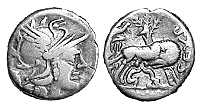
|
Sextus Pompeius Fostulus (c. 137 BC) Pompeia 1 Denarius Head of Roma right, 'X' below chin, jug before. Wolf suckling the Twins, shepard at left, birds in fig tree behind. 'SEX. POM. FOSTVLVS' |
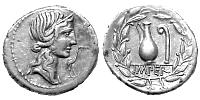
|
Q. Caecilius Metellus Pius (as Imperator) (c. 81 BC) Caecilia 44 Denarius Diademed head of Pietas right, stork before Lituus and jug with handle, 'IMPER' in exergue, all within laurel wreath. |
